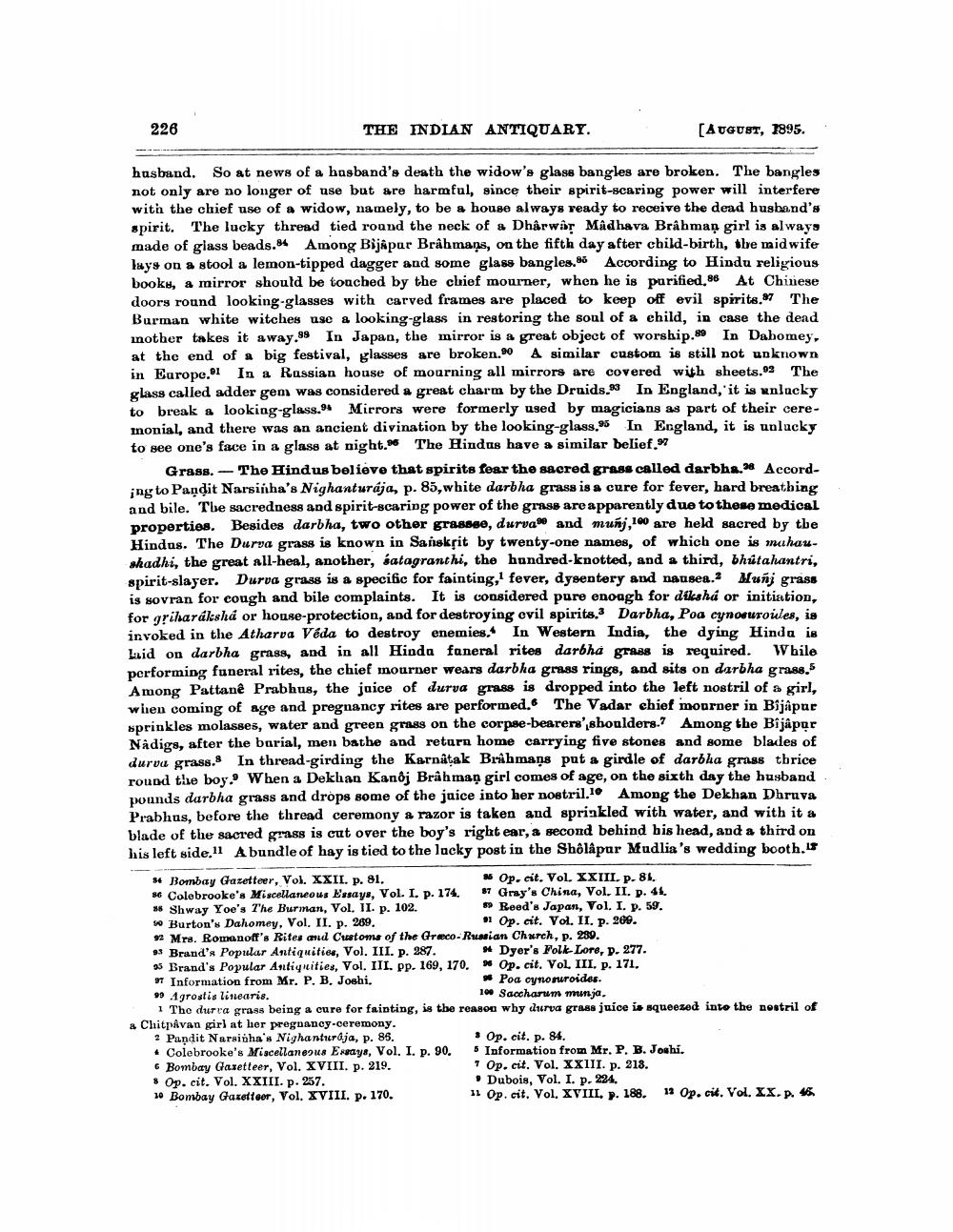________________
226
THE INDIAN ANTIQUARY.
[AUGUST, 1895.
husband. So at news of a husband's death the widow's glass bangles are broken. The bangles not only are no longer of use but are harmful, since their spirit-scaring power will interfere with the chief use of a widow, namely, to be a house always ready to receive the dead husband's spirit. The lucky thread tied round the neck of a Dharwar Madhava Brahman girl is always made of glass beads. Among Bijapur Brâhmaņs, on the fifth day after child-birth, tbe midwife lays on a stool a lemon-tipped dagger and some glass bangles. According to Hindu religious books, a mirror should be touched by the chief mourner, when he is purified. 86 At Chinese doors round looking-glasses with carved frames are placed to keep off evil spirits.87 The Burman white witches use a looking-glass in restoring the soul of a child, in case the dead inother takes it away.89 In Japan, the mirror is a great object of worship.89 In Dabomey, at the end of a big festival, glasses are broken. A similar custom is still not unknown in Earope. In a Rassian house of mourning all mirrors are covered with sheets.92 The glass called adder gem was considered a great charm by the Druids. In England, it is unlucky to break a looking-glass. Mirrors were formerly used by magicians as part of their ceremonial, and there was an ancient divination by the looking-glass. In England, it is unlucky to see one's face in a glass at night. The Hindus have a similar belief."
Grass. - The Hindus believe that spirits fear the sacred grass called darbhs. According to Pandit Narsinha's Nighanturája, p. 85, white darbha grass is a cure for fever, hard breathing and bile. The sacredness and spirit-scaring power of the grass are apparently due to these medical properties. Besides darbha, two other grassse, durva and munj,100 are held sacred by tbe Hindus. The Durva grass is known in Sanskrit by twenty-one names, of which one is mahaushadhi, the great all-heal, another, satagranthi, the hundred-knotted, and a third, bhútahantri, spirit-slayer. Durva grass is a specific for fainting, fever, dysentery and nausea.2 Muñj grass is sovran for cough and bile complaints. It is considered pure enough for diksha or initiation, for griharákshi or house-protection, and for destroying evil spirits. Darbha, Poa cynosuroules, is invoked in the Atharva Veda to destroy enemies. In Western India, the dying Hinda is Luid on darbha grass, and in all Hinda faneral rites darbha grass is required. While performing funeral rites, the chief mourner wears darbha grass rings, and sits on darbha grass.5 Among Pattanê Prabhus, the juice of durva grass is dropped into the left nostril of a girl, wien coming of age and pregnancy rites are performed. The Vadar chief mourner in Bijâpar sprinkles molasses, water and green grass on the corpse-bearers' shoulders. Among the Bijâpar Nadigs, after the burial, men bathe and return home carrying five stones and some blades of durva grass. In thread-girding the Karnatak Brahmans put a girdle of darbha grass tbrice round the boy. When a Dekhan Kanoj Brahman girl comes of age, on the sixth day the husband pounds darbha grass and drops some of the juice into her nostril. Among the Dekhan Dhruva Prabhus, before the thread ceremony a razor is taken and sprinkled with water, and with it a blade of the sacred grass is cut over the boy's right ear, a second behind bis head, and a third on his left side. 11 A bundle of hay is tied to the lucky post in the Shôlâpur Mudlia's wedding booth.
** Bombay Gazetteer, Vol. XXII. p. 81.
* Op. cit. Vol. XXIII. p. 81. 36 Colebrooke's Miscellaneous Emaye, Vol. I. p. 174. Gray's China, Vol. II. p. 41 $6 Shway Yoe's The Burman, Vol. II. p. 102.
99 Reed's Japan, Vol. I. p. 59. so Burton's Dahomey, Vol. II. p. 269.
1 Op. cit. Vol. II. p. 200. 93 Mrs. Romanoff's Rites mid Customs of the Greco-Russian Church, p. 289.
Brand's Popular Antiquities, Vol. III. p. 287. * Dyer's Foll-Lore, p. 277. 95 Brand's Popular Antiquities, Vol. III. pp. 169, 170, Op. cit. Vol. III. p. 171. 17 Information from Mr. P. B. Joshi,
* Poa cynosuroides. 99 Agrostis linearis.
100 Saccharum munja. 1 The durva grass being a cure for fainting, is the reason why durva grasa juice is squeezed into the nostril of a Chitpåvan girl at lier pregnancy ceremony. ? Pandit Narsinha's Nighanturaja, p. 85.
Op. cit. p. 84. • Colebrooke's Miscellaneous Expays, Vol. I. p. 90. Information from Mr. P. B. Joshi. Bombay Gazetteer, Vol. XVIII. p. 219.
7 Op. cit. Vol. XXIII. p. 218. & Op.cit. Vol. XXIII. p. 257.
. Dubois, Vol. I. p. 224. 10 Bombay Gazetteer, Vol. XVIII. p. 170.
11 Op.cit, Vol. XVIII. p. 188. 13 Op.cit. Vol. XX.p. 45




